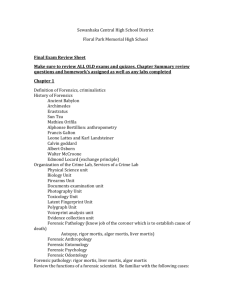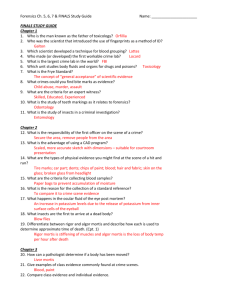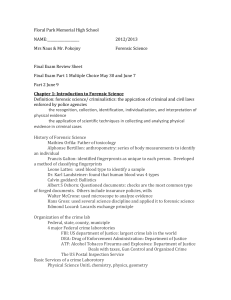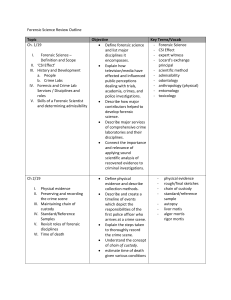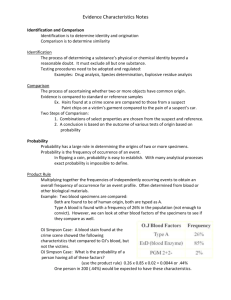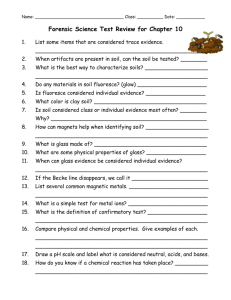Sewanhaka Central High School District Floral Park Memorial High
advertisement
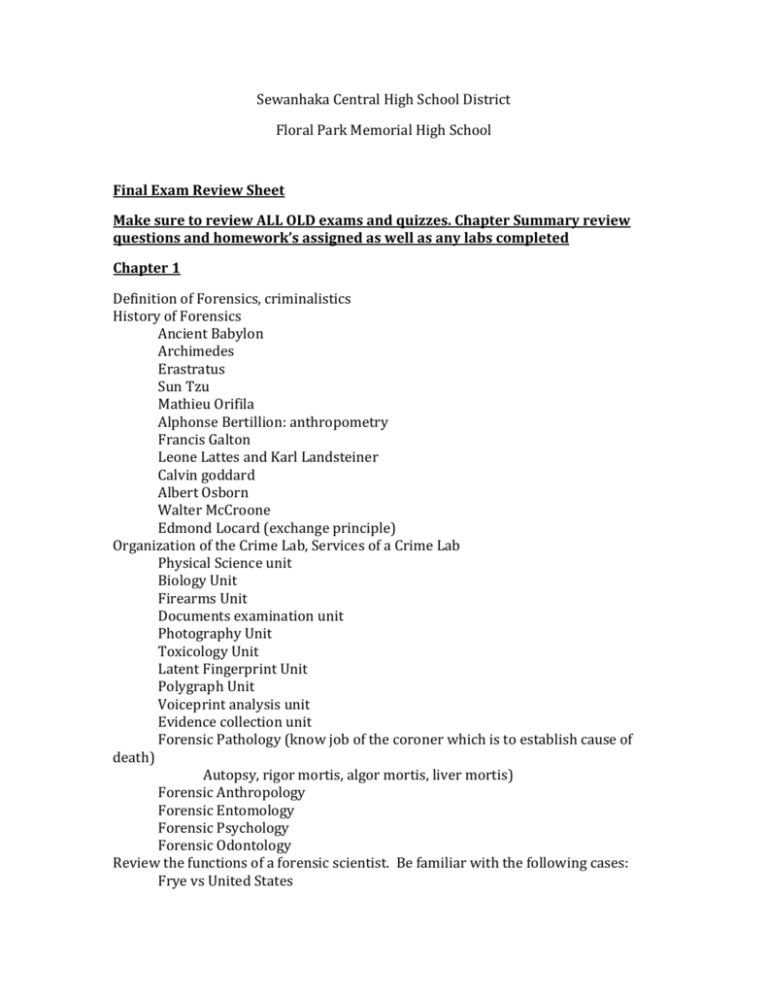
Sewanhaka Central High School District Floral Park Memorial High School Final Exam Review Sheet Make sure to review ALL OLD exams and quizzes. Chapter Summary review questions and homework’s assigned as well as any labs completed Chapter 1 Definition of Forensics, criminalistics History of Forensics Ancient Babylon Archimedes Erastratus Sun Tzu Mathieu Orifila Alphonse Bertillion: anthropometry Francis Galton Leone Lattes and Karl Landsteiner Calvin goddard Albert Osborn Walter McCroone Edmond Locard (exchange principle) Organization of the Crime Lab, Services of a Crime Lab Physical Science unit Biology Unit Firearms Unit Documents examination unit Photography Unit Toxicology Unit Latent Fingerprint Unit Polygraph Unit Voiceprint analysis unit Evidence collection unit Forensic Pathology (know job of the coroner which is to establish cause of death) Autopsy, rigor mortis, algor mortis, liver mortis) Forensic Anthropology Forensic Entomology Forensic Psychology Forensic Odontology Review the functions of a forensic scientist. Be familiar with the following cases: Frye vs United States Daubert vs Merrell Dow Pharmaceutical Inc. Kumho Tire Company Ltd vs Carmichael Coppolino vs United States Michigan vs Loren Tyler (Chapter 2) Jon Benet Ramsey murder and investigation (Chapter 3) Chapter 2 The Crime Scene Know the steps in processing the crime scene What Is Physical evidence and know types of physical evidence? What is testimonial evidence? What is expert testimony? Processing the crime scene Secure and isolate the crime scene Record the crime scene Photography Sketching Rough sketch vs finished scetch Computer Aided Drafting (CAD) Finished sketch must contain polarity (N,S,E,W), Room measurements key or legend, At least two reference points for each piece of physical evidence. Know the polarity of room 239. Hempstead Turnpike is South, Jericho North, Plainfield Avenue West, Locust Street East Note taking Conduct a systematic search for evidence Spiral search method Grid method Strip or line search Quadrant or zone search Evidence collected and maintained from a body for lab examination Tissues and organs Vicim’s clothing Fingernail scrapings Head and pubic hairs Blood (for DNA) Vaginal, anal, and oral swabs Recovered bullets or weapons Hand swabs from shooting victims for Gun shot residue Collect and Package evidence How are different pieces of evidence gathered from a crime scene and how are they packaged? Use of vacuum, tweezer etc. what type of containers are used to package evidence? What is a druggist fold when is it used? How are blood stained items handled? How are articles of clothing handled? Maintain Chain of Custody Obtain Standard or Reference Samples What is a standard or reference sample and why is it important? Buccal swab Substrate controls Chapter 3 Physical Evidence Types of physical evidence Blood,semen,saliva,documents(handwriting)drugs,explosives,fibers,hairs,fin gerprints,firearms and ammunition, glass, impressions, paint, petroleum products, plastic, rubber, powder residue, serial numbers, soil, minerals, tool marks and impressions, vehcle lights, wool and other vegetative matter Identification Comparison Individual vs class evidence Crime scene reconstruction Chapter 4 Glass and soil Physical Propertie vs Chemical property Examples of physical properties Mass, weight, temperature, density Properties of density Refractive index: the bending of light from one source to another Birefringence Dispersion Types of glass Tempered glass Laminated glass Plexi glass Annealed glass Fiber glass Properties of glass Beck Line, match point, refractive index Glass fractures Radial vs concentric Bullet hole entrance and exit(wider) Order of bullet holes based on the fracture pattern. Fractures terminate at existing fracture lines Characteristics of soil Specifically the soil lab What does shining a UV light on a soil sample tell us? What does the color of the soil tell us? What does the pH of the soil tell us? What causes a soil sample to be acidic? Basic? Chapter 5 Organic Analysis Specifically I am concentrating on the different processes of Chromatography Electrophoresis and Spectrophotometry How does chromatography work? Difference between solute and solvent What are the four characteristics that separate a solute? Why is there a stationary and mobile phase in the process of chromatography? How does gas chromatography work? What does it mean to pyrolize a sample and why would you have to do it? Know how to read a chromatogram Faster moving substances register first. What makes a solute move faster? What is retention time? Qualitative(retention time) vs quantitative (peak height)analysis High Performance liquid chromatography Thin Layer chromatography What is the Rf value and what information does it give us? How does gel electrophoresis work? (don’t forget it id proteins and DNA) What is the electromagnetic spectrum? What is visible light? Wavelength Frequency of light How does the wavelength and frequency of light change as you move through the electromagnetic spectrum? Function of spectrophotometer: measures selective absorption of a substance Used to measure UV,visible or infrared light absorption by a substance Why is infrared spectra equivalent to a fingerprint? How does Mass spectrometry work? Uses Gas chromatography to separate mixture which then passes through a high vacuum container that shoots a beam of electrons through the components causing molecules to loose electrons forming positively charged ions which immediately decompose they are passed through an electric or magnetic field and separate by mass. This produces a fragment pattern Chapter 6: Concentrate on x-ray diffraction X-ray diffraction gives insight as to how elements combine Produces a unique diffraction pattern depending on crystalline structure Chapter 7: concentrate on the Polarizing Microscope and the Microspectrophotometer How does a polarizing microscope work What is polarized light? Microspectrophotometer is used to analyze paint fiber and ink Displays exact wavelength of color absorption Chapter 8: Hairs Fibers and Paint Review power point and exam Chapter 9 Drugs Review power point and exam
